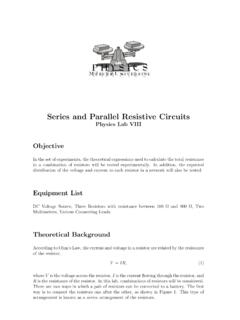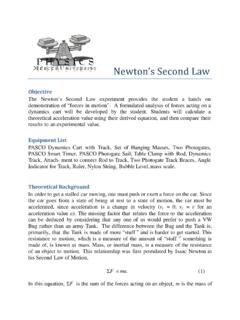Transcription of Standing Waves - Physics Department | College of Liberal Arts
1 Standing WavesPhysics Lab IObjectiveIn this series of experiments, the resonance conditions for Standing Waves on a string willbe tested ListPASCO SF-9324 Variable Frequency Mechanical Wave Driver, PASCO PI-9587B DigitalFrequency Generator, Table Rod, Elastic String, Table Clamp with Pulley, Set of 50gand 100gMasses with Mass Holder, Meter BackgroundConsider an elastic string. One end of the string is tied to a rod. The other end is undertension by a hanging mass and pulley arrangement. The string is held taut by the appliedforce of the hanging mass.
2 Suppose the string is plucked at or near the taut end. Thestring begins to vibrate. As the string vibrates, a wave travels along the string towardthe fixed end. Upon arriving at the fixed end, the wave is reflected back toward the tautend of the string with the same amount of energy given by the pluck, you were to repeatedly pluck the string. The time between each pluck is1 second and you stop plucking after 10 seconds. Thefrequencyof your pluck is thendefined as 1 pluck per every second. Frequency is a measure of the number of repeatingcycles or oscillations completed within a definite time frame.
3 Frequency has units ofHertz abbreviated you continue to pluck the string you notice that the set of Waves travelling backand forth between the taut and fixed ends of the string constructively and destructivelyinteract with each other as they propagate along the string. The wave patterns moveleft to right and right to left from end to end as a result of constructive and destructiveinteractions for the given frequency (1 pluck per second). At certain frequencies howeverthe interaction between the Waves from either end is not present and the resulting wavepattern is astanding wave.
4 Standing Waves occur when there is no left or right motion2 Standing Wavesof the wave patterns. Frequencies producing Standing Waves areresonant 1 shows the first and second set of Standing wave patterns for a string held 1: Standing Waves on a StringAs shown on Figure 1, the stationary string positions in the Standing wave patternare known asnodes, while the positions with maximum amplitude in the pattern areknown asantinodes. The first Standing wave pattern is referred to as thefundamentalorfirst harmonicof the string. In this pattern, there are no nodes between the twoends of the string (the fixed ends are nodes for the pattern, though they are generallydisregarded since they are present in all the patterns).
5 The next Standing pattern, withone node between the two ends, is known as thesecond harmonic. Standing Waves withmore nodes between the ends are higher harmonics ( third harmonic, forth harmonic,etc.).It is possible to determine the resonant frequencies for Standing Waves on a string byconsidering some properties of the Standing wave and the string. First notice that thedistance between two nodes represents half a wavelength, , of the Standing wave, asshown as in Figure 1. The wavelength can be related to the length bounded by the twoends.
6 This is the length of the string undergoing propagation,L. For the fundamental,one half of the full wavelength is contained within the bounds. For the second harmonic,one full wavelength is contained within bounds. The third harmonic would have twonodes, which would mean there would be one and a half wavelengths between the stringends. The progression of wavelengths can be expressed by the following mathematicalequation: n=2 Lnn= 1,2,3..(1)In this equation, nis the wavelength of the Standing wave,Lis the length of the stringbounded by the left and right ends, andnis the Standing wave pattern, or harmonic,number.
7 For the fundamental,nwould be one; For the second harmonic,nwould betwo, etc. The resonant frequency can be found by using the relationship between thewavelength and the frequency for Waves as shown in the following equation:v= f.(2)v:F06 Standing Waves3In this equation, v is the (phase) velocity of the Waves on the string, is the wavelengthof the Standing wave, andfis the resonant frequency for the Standing wave. For waveson a string the velocity of the Waves is given by the following equation:v= T , =m`.(3)In this equation,vis the velocity of the Waves on the string,Tis the tension in the string,and is the mass density of the string given by the total mass of the stringmdividedby the total length of the string`.
8 Note:`includes the length of the string bounded bythe left and right ends and the length of the string stretched by the hanging relationships will be tested experimentally in this series of 2: Experimental ArrangementWave velocity DeterminationIn this section, the propagation speed for Waves on the stretched string used in this seriesof experiments will be 200gon the mass holder which is draped over the table. Record the massof the hanging weight on your data sheet asM; Be sure to include the mass of the length of the stretched string from the end of the wave driver to thecenter of the pulley.
9 Record this length on your data sheet the power turned off, turn the amplitude on the frequency generator down toits minimum setting. With the amplitude at its minimum setting, turn the poweron and set the range Do this by pressing the down arrow (5) onthe function :F064 Standing the frequency adjustment down until the frequency display reads about the frequency adjustment set to 5Hz, turn the amplitude adjustment to halfway between the minimum and maximum the frequency until the fundamental Standing wave mode is excited on thestring.
10 Continue increasing the frequency until this mode reaches its maximumamplitude value. Note, the amplitude referred to here is measured should see the height of wave pattern increase as the frequency maximum frequency value corresponding to the maximum height of the stringshould be recorded. It is important that the amplitude adjust knob on the frequencygenerator remains as a Function of WavelengthIn this portion of the lab, the frequency the higher harmonic modes will be the string vibrating in the fundamental Standing wave mode, continue increas-ing the drive frequency to find the higher harmonics.







